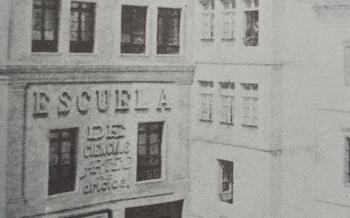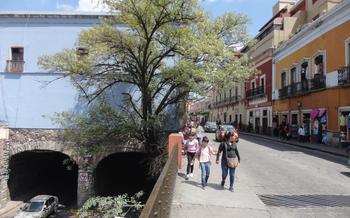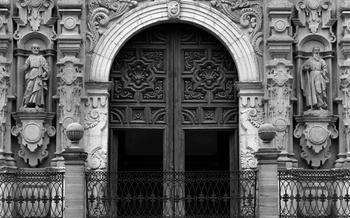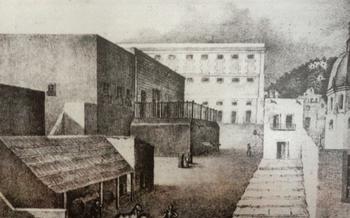
Rana Plaza
- Historical Significance
- Architecture and Design
- Museo Casa Diego Rivera
- Teatro Juarez
- Funicular Panoramico: A Scenic Journey Through Guanajuato
- Mercado Hidalgo: A Vibrant Heartbeat of Guanajuato
- Jardin de la Union
- Casa del Conde Rul
- Museo de las Momias
- Insider Tip:
Historical Significance
The Rana Plaza stands as a testament to Guanajuato's rich mining heritage. Constructed in the 19th century during the city's mining boom, the plaza served as a gathering place for miners, merchants, and visitors alike. Its strategic location near the city's main silver mines made it a hub of economic activity, where miners would trade their precious metals for goods and services.
The plaza's architectural style reflects the eclectic mix of influences that shaped Guanajuato's identity. Its neoclassical facade, with its elegant arches and columns, is reminiscent of European architecture, while its intricate carvings and colorful tiles showcase the influence of indigenous Mexican traditions.
Over the centuries, the Rana Plaza has witnessed countless historical events. It has been a stage for celebrations, protests, and revolutions. Locals and visitors alike have gathered here to mark important occasions, share stories, and forge connections, making the plaza an integral part of the city's social and cultural fabric.
Architecture and Design
The architectural style of the Rana Plaza is a testament to the grandeur and opulence of Guanajuato's mining era. The plaza is adorned with a series of elegant arches, supported by sturdy columns, that create a sense of symmetry and harmony. The intricate carvings that embellish the arches and columns showcase the skill and artistry of the craftsmen who worked on the plaza's construction.
The central fountain, with its cascading tiers and delicate sculptures, serves as the focal point of the plaza. The fountain is surrounded by a series of benches, inviting visitors to linger and soak in the tranquil atmosphere. The plaza's layout is designed to encourage interaction and socialization, with wide walkways and open spaces that allow for easy movement and conversation.
Over the years, the Rana Plaza has undergone several restoration and preservation efforts to maintain its original charm and architectural integrity. These efforts have been successful in preserving the plaza's unique character and ensuring that it continues to serve as a beloved gathering place for locals and visitors alike.
Museo Casa Diego Rivera
The Museo Casa Diego Rivera is a must-visit for art enthusiasts and history buffs alike. Located within the Rana Plaza, the museum is dedicated to the life and work of renowned Mexican artist Diego Rivera. Born in Guanajuato in 1886, Rivera spent his childhood in this very house, which has since been transformed into a museum showcasing his artistic journey.
The museum houses a collection of Rivera's early works, including paintings, drawings, and sketches, that offer a glimpse into his development as an artist. Visitors can also view personal belongings and artifacts that provide insights into his life and influences. The museum's collection includes some of Rivera's most iconic works, such as "The Flower Seller" and "The Song of the Volcano," which showcase his unique style and commitment to social and political themes.
Teatro Juarez
Guanajuato's cultural and artistic legacy is brought to life at the Teatro Juarez, a majestic theater that has served as a stage for countless performances and events. Established in 1873, the theater stands as a testament to the city's rich heritage and its enduring love for the arts.
Its architectural style, a harmonious blend of Neoclassical and Romantic elements, captures the essence of 19th-century Mexican architecture. The imposing facade, adorned with intricate carvings and sculptures, hints at the grandeur that awaits within. Inside, the theater's opulent interior features a horseshoe-shaped auditorium, adorned with plush red velvet seats and intricate gold leaf details.
Over the years, the Teatro Juarez has hosted a diverse range of performances, from traditional Mexican plays and operas to international ballet and music concerts. Its stage has witnessed the talents of renowned artists, both local and international, who have graced its hallowed halls with their artistry.
One of the most notable events held at the Teatro Juarez is the annual Cervantino International Festival, a prestigious cultural festival that attracts artists and performers from around the world. During this festival, the theater becomes a hub of artistic expression, showcasing a variety of performances, exhibitions, and workshops that celebrate the diversity and richness of Mexican and international culture.
Whether attending a performance or simply admiring its architectural beauty, the Teatro Juarez offers visitors a glimpse into Guanajuato's vibrant cultural scene and its deep appreciation for the arts.
Funicular Panoramico: A Scenic Journey Through Guanajuato
Amidst the vibrant streets and colorful alleys of Guanajuato, the Funicular Panoramico stands as a unique and charming mode of transportation. This funicular railway, inaugurated in 1903, connects the city center with the Cerro del Cubilete, offering breathtaking panoramic views of the city and the surrounding mountains.
The Funicular Panoramico operates on a simple yet effective principle. Two counterbalanced cars, each with a capacity of 24 passengers, ascend and descend the steep incline using a single cable. The journey takes approximately four minutes, providing ample time to marvel at the stunning vistas.
As the funicular climbs, passengers are treated to a bird's-eye view of Guanajuato's iconic landmarks, including the Teatro Juarez, the Alhondiga de Granaditas, and the Monumento al Pipila. The cityscape unfolds like a colorful tapestry, with its narrow streets, pastel-painted houses, and countless domes and spires.
At the summit of Cerro del Cubilete, visitors alight from the funicular and are greeted by the Templo Expiatorio del Sagrado Corazon, a majestic neo-Gothic church that dominates the skyline. From the church's esplanade, visitors can enjoy unparalleled views of the city and the surrounding countryside, stretching for miles in every direction.
The Funicular Panoramico is not merely a means of transportation; it is an attraction in its own right. The scenic journey through Guanajuato's historic center and the panoramic vistas from the summit of Cerro del Cubilete make it a must-do experience for any visitor to this enchanting city.
Mercado Hidalgo: A Vibrant Heartbeat of Guanajuato
In the heart of Guanajuato, where the city's pulse beats strongest, lies the Mercado Hidalgo, a vibrant and bustling marketplace that encapsulates the essence of Mexican culture and tradition. Step into this labyrinth of stalls and shops, and you'll be greeted by a symphony of sights, sounds, and aromas that will transport you to a world of local treasures.
Wander through the narrow aisles, past colorful displays of handmade crafts, intricate textiles, and an array of souvenirs that reflect the region's rich artistic heritage. From intricate pottery and gleaming silver jewelry to hand-woven rugs and vibrant bordados (embroidered blouses), the Mercado Hidalgo is a treasure trove of authentic Mexican craftsmanship.
Indulge your senses with the tantalizing aromas wafting from the food stalls, where vendors tempt you with freshly prepared delicacies. Savor the flavors of traditional Mexican dishes such as enchiladas, tacos, and tamales, or sample the local specialty, the mouthwatering "guacamayas," a unique sandwich filled with chicharrones (fried pork rinds) and salsa.
The Mercado Hidalgo is not just a place of commerce; it's a meeting point for locals and visitors alike, a place to socialize, exchange stories, and experience the warmth of Mexican hospitality. As you navigate the maze-like corridors, you'll catch glimpses of daily life, from mothers bargaining for the best prices to street musicians serenading shoppers with traditional tunes.
Embrace the vibrant energy of the Mercado Hidalgo, soak in the local atmosphere, and discover the true essence of Guanajuato. Whether you're searching for unique souvenirs, savoring local delicacies, or simply seeking a glimpse into the heart of Mexican culture, this bustling marketplace is an unmissable experience.
Jardin de la Union
The Jardin de la Union is the heart and soul of Guanajuato, a vibrant central square that serves as the main gathering place for locals and visitors alike. Once a bustling marketplace, the Jardin de la Union was transformed into a public square in the 19th century and has since become a symbol of the city's rich history and culture.
Surrounded by colorful colonial buildings, the Jardin de la Union is a feast for the eyes. The square is dominated by the majestic Teatro Juarez, a stunning example of neoclassical architecture that hosts a variety of cultural events and performances. The Jardin also features a beautiful fountain, lush gardens, and a bandstand where musicians entertain the crowds with traditional Mexican music.
As the sun sets, the Jardin de la Union comes alive with activity. Locals and tourists alike gather to stroll, socialize, and enjoy the lively atmosphere. Street vendors sell traditional snacks and souvenirs, while musicians and performers entertain the crowds. The Jardin de la Union is also a popular spot for festivals and celebrations, with events ranging from traditional Mexican dances to modern music concerts.
Whether you're looking to soak up the local culture, enjoy a leisurely stroll, or simply people-watch, the Jardin de la Union is the place to be in Guanajuato. This vibrant square is a testament to the city's rich history and vibrant spirit, and it's a must-visit for any traveler.
Casa del Conde Rul
The Casa del Conde Rul is a magnificent historical mansion located in the heart of Guanajuato. Built in the 18th century, it was once the residence of Don Jose Mariano Rul, a wealthy mining magnate who played a significant role in the city's development. The mansion's architectural style is a testament to the opulence and grandeur of the mining era, featuring intricate carvings, ornate balconies, and a grand central courtyard. After the Rul family's departure, the mansion underwent several transformations, serving as a school, a government building, and eventually a cultural center.
Today, the Casa del Conde Rul is open to the public as a museum and cultural center. Visitors can explore its beautifully preserved rooms, which showcase period furniture, artwork, and artifacts that provide a glimpse into the life and times of the Rul family and the city's mining heritage. The mansion also hosts a variety of cultural events, exhibitions, and workshops throughout the year, making it a vibrant hub for the local community and a must-visit destination for anyone interested in Guanajuato's rich history and culture.
Museo de las Momias
The Museo de las Momias is a one-of-a-kind museum that houses a collection of naturally mummified bodies, offering a glimpse into the unique funerary practices of Guanajuato. The mummies, which date back to the 19th century, were discovered in the local cemetery when officials noticed that the bodies were not decomposing as expected. This phenomenon is attributed to the unique combination of the region's dry climate, high altitude, and the mineral-rich soil in which the bodies were buried. The result is a collection of remarkably preserved mummies that provide a fascinating insight into the lives and deaths of Guanajuato's inhabitants from a bygone era.
Visitors to the museum are greeted with a display of mummies in various states of preservation, showcasing the different stages of the mummification process. The exhibits offer detailed explanations of the scientific and cultural factors that contributed to the mummies' unique condition. Among the most notable mummies are those of a young woman known as "La Novia" (The Bride), who is still wearing her wedding dress, and a man nicknamed "El Pipila," who is said to have been a hero of the Mexican War of Independence.
The Museo de las Momias is a must-visit for anyone interested in the macabre or in gaining a deeper understanding of Guanajuato's rich history and culture. The museum serves as a reminder of the fragility of life and the enduring power of human memory.
Insider Tip:
To fully immerse yourself in the vibrant atmosphere of the Rana Plaza, plan your visit during the annual Cervantino International Festival, held in October. This renowned cultural extravaganza transforms the city into a stage, showcasing a diverse array of performances, concerts, and exhibitions. The festival provides a unique opportunity to experience Guanajuato's rich artistic heritage and witness the Rana Plaza come alive with music, dance, and laughter.
For an authentic culinary experience, venture beyond the tourist hotspots and explore the hidden gems of Guanajuato's culinary scene. Seek out the traditional "mercados" (markets) and local eateries where you can savor the flavors of regional specialties such as "enchiladas mineras," "pozole," and "tacos al pastor." These local establishments offer a glimpse into the daily lives of Guanajuato's residents and provide an unforgettable gastronomic adventure.









